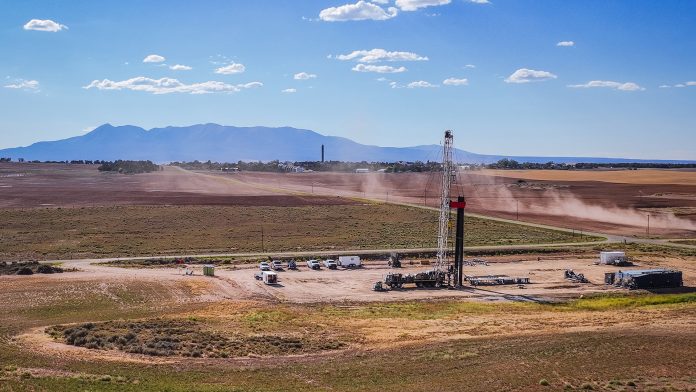Determined to advance helium exploration in the US, Four Corners Helium is taking efficient and innovative approaches to its projects.
To date, Four Corners Helium (FCH) has achieved multiple milestones. These include marketing the SE Utah Red Helium project to Australian-based Grand Gulf Energy in March 2021; entering an exclusive arrangement with the Ute Mountain Utes in southwest Colorado to explore their more than 500,000 acres of tribal lands for helium; and forming a joint development agreement with Leipzig Energy to economically strip helium from flare gas – creating blue hydrogen in the process.
Tim Rynott, Founder of FCH, has been an invited speaker for helium presentations in three Colorado cities (Durango, Grand Junction, Denver), as well as Houston, Texas. Rynott also organised and participated in one of Gasworld’s most successful webinars in its history, with over 900 registrants.
A primary goal of Four Corners Helium is to target locations that will be economically unaffected once new Russian helium supplies abate prices in two to three years. Additionally, FCH is working to help pump enough domestic helium into the US market to offset the rapidly declining Federal Helium Reserve. North America has never been a net importer of helium and the collective of helium explorers are determined to perpetuate this status quo.
Coyote Wash Project: Ute Mountain Utes
Like many Native American communities around the United States, tribes who were historically dependent on oil and gas revenues are finding themselves pushed by the U.S. Interior Department to diminish their dependency on oil and gas revenue. Reliance on these revenues varies from tribe to tribe, and Mother Nature’s mineral lottery is separating the ‘haves’ from the ‘have-nots’. For the Ute Mountain Utes, their lottery ticket comes in the form of helium. Four Corners Helium has identified an initial seven-well drilling programme with projected flow rates of 5-10 million feet of helium per day and helium percentages at 2-3%. Utilising the Ute’s robust 2D and 3D seismic library has been instrumental in de-risking the subsalt Mississippian Leadville formation. Seismic reprocessing by our partner eSeis Inc, provides patented direct detection techniques for identifying porosity compartments – a key element in exploring complex Mississippian carbonates.
FCH desires to improve the financial livelihood of the Ute Mountain Utes while at the same time respecting their lands as if they were our own. In addition to taking advantage of a massive solar project positioned within mere miles of our proposed drilling locations, Four Corners Helium is investigating a sophisticated filtering system for converting produced water for urgent agricultural needs. In addition, analysis is underway to eliminate ecologically damaging flare gas by using steam methane reform to convert the methane-based flare gas into blue hydrogen and market-grade CO2. From an economic perspective, blue hydrogen is presently advantageous over green hydrogen, while the viability of white hydrogen is still being researched.
Timing is everything, and FCH is excited to announce the Utes have begun a strategic re-structuring of its tribal governance. Modelled after the Colorado-based Southern Utes, one of the most business-savvy Indigenous communities in North America, the Ute Mountain Utes will be streamlining their regulatory and managerial departments. Becoming more industry friendly will allow the Ute Mountain Utes to catch up with their helium-savvy next-door neighbour – the Navajo Nation.
In three quick years, NASCO, NTEC, and the NNOGC have drilled over 15 new helium discoveries on Navajo lands. Geologically, the Ute Mountain Utes and Navajos are situated on the Four Corners Platform – a 1,000-square-mile area containing a vast number of undrilled structural closures with helium concentrations reaching 8%. Other than the Yurubchen-Tokhomo complex in eastern Siberia, and southeast Utah in the United States, it is hard to find more promising geological conditions for discovering significant helium accumulations.
The Red Helium Project: Southeast Utah
Two deep Mississippian tests drilled by Four Corners Helium partner, Grand Gulf Energy (ASX:GGE), combined with 150 linear miles of reprocessed 2D seismic, has helped to confirm a deep-seated paleo-ridge covering almost 200 square miles and containing at least seven separate helium reservoirs in a minimum of three fault blocks. Thick, vugular dolomites associated with this huge feature are overlain by 1,200’- 2,000’ of Akah salts and anhydrites – creating the perfect seal.
This newly acquired data by the partnership demonstrates a helium system with distinct geologic similarities to Doe Canyon Field, located ~17 miles to the east. Originally drilled by Kinder Morgan, who later teamed with Air Products, Doe Canyon is an ~8000 ac dolomitic CO2 reservoir which has produced ~530 BCF (>95% from only ten wells) to date with an overall average of 0.4% helium. With an expected EUR of~850 BCF, Doe Canyon could ultimately yield 3 to 3.5 BCF in helium resource from an area 1/16th the size of the Red Project (although heterogenic porosities and permeabilities have the potential to cut this comparison by half).
With the Air Products’ helium processing plant currently running at only 50% capacity, and Kinder Morgan’s adjacent 36-inch pipeline carrying CO2 to the Permian running at ~60% capacity, it is easy to claim the Red project is sitting in an enviable location with potential helium reserves of 10-15 billion cubic feet, and CO2 reserves in excess of one trillion cubic feet.
In addition, FCH and GGE have been capturing key new leases positions. This major development will expeditiously advance a much-anticipated state-of-the-art 3D survey, which will be a potential gamechanger for pinpointing elusive porosity pockets in the complex carbonate reservoir rock, and will exploit the 200’ gas column height proven by the initial Jesse 1A discovery.
Helium exploration: Looking ahead
In the realm of pure play helium exploration – outside of FCH/GGE, North American Helium, and Avanti Helium – helium exploration has been developing at a snail’s pace. Is this disconcerting? Yes. The Federal Helium Reserve currently supplies 35-40% of America’s helium needs but is nearly 90% depleted. Due to the complexity of the reservoir, it’s a matter of debate whether the Reserve will be depleted in a matter of three to five years, or if it will last into the mid-2030s. The former prediction causes great consternation. Grab your pick and shovel, we’ve got work to do.
Please note, this article will also appear in the fifteenth edition of our quarterly publication.









